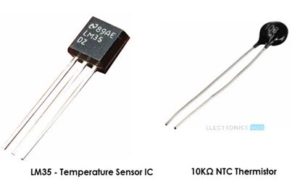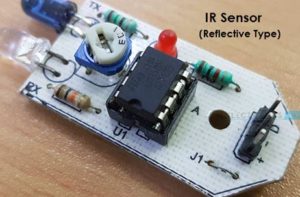Introduction to Sensors
The world is full of sensors. In our day-to-day life, we come across automation in all the activities. Automation includes turning on lights and fans using mobile phones, controlling TV using mobile apps, adjusting the room temperature, smoke detectors, etc. All these are done with help of sensors. These days, any embedded system based product has inbuilt sensors in it.
There are many applications like Mobile controlled CCTV camera, weather monitoring and prediction apps, etc. Sensors play a very vital role in Healthcare monitoring and detection. Therefore, before building an application-using sensor, we must understand what exactly does a sensor do and how many types of sensors are available.
What is a Sensor?
Sensor is device that detects and responds to some type of input from the physical environment. The specific input could be light, heat, motion, moisture, pressure, or any one of a great number of other environmental phenomena.

The simplest example of a sensor is an LDR or a Light Dependent Resistor. It is a device, whose resistance varies according to intensity of light it is subjected to. When the light falling on an LDR is more, its resistance becomes very less and when the light is less, well, the resistance of the LDR becomes very high.
We can connect this LDR in a voltage divider (along with other resistor) and check the voltage drop across the LDR. This voltage can be calibrated to the amount of light falling on the LDR. Hence, a Light Sensor.
Now that we have seen what a sensor is, we will proceed further with the classification of Sensors.
Real Time Application of Sensors
The example we are talking about here is the Autopilot System in aircrafts. Almost all civilian and military aircrafts have the feature of Automatic Flight Control system or sometimes called as Autopilot.

An Automatic Flight Control System consists of several sensors for various tasks like speed control, height, position, doors, obstacle, fuel, maneuvering and many more. A Computer takes data from all these sensors and processes them by comparing them with pre-designed values.
The computer then provides control signal to different parts like engines, flaps, rudders etc. that help in a smooth flight. The combination of Sensors, Computers and Mechanics makes it possible to run the plane in Autopilot Mode.
All the parameters i.e. the Sensors (which give inputs to the Computers), the Computers (the brains of the system) and the mechanics (the outputs of the system like engines and motors) are equally important in building a successful automated system.
But in this tutorial, we will be concentrating on the Sensors part of a system and look at different concepts associated with Sensors (like types, characteristics, classification etc.).
Classification of Sensors
- Active and Passive Sensors
- Analog and Digital Sensors
Active Sensors:
Active sensors are the type of sensors that produces output signal with help of external excitation supply. The own physical properties of the sensor varies with respect to the applied external effect. Therefore, it is also called as Self Generating Sensors.
Examples: LVDT and strain gauge.
Passive Sensors:
Passive sensors are the type of sensors that produces output signal without the help of external excitation supply. They do not need any extra stimulus or voltage.
Example: Thermocouple, which generates a voltage value corresponding to the heat, applied. It does not require any external power supply.
Analog and Digital Sensors
Different types of digital and analog sensors are listed below one by one with their applications.
Different Types of Sensors
The following is a list of different types of sensors that are commonly used in various applications. All these sensors are used for measuring one of the physical properties like Temperature, Resistance, Capacitance, Conduction, Heat Transfer etc.
- Temperature Sensor
- Proximity Sensor
- Accelerometer
- IR Sensor (Infrared Sensor)
- Pressure Sensor
- Light Sensor
- Ultrasonic Sensor
- Smoke, Gas and Alcohol Sensor
- Touch Sensor
- Color Sensor
- Humidity Sensor
- Tilt Sensor
- Flow and Level Sensor
We will see about few of the above mentioned sensors in brief. More information about the sensors will be added subsequently. A list of projects using the above sensors is given at the end of the page.
Temperature Sensor
One of the most common and most popular sensor is the Temperature Sensor. A Temperature Sensor, as the name suggests, senses the temperature i.e. it measures the changes in the temperature.

In a Temperature Sensor, the changes in the Temperature correspond to change in its physical property like resistance or voltage.
There are different types of Temperature Sensors like Temperature Sensor ICs (like LM35), Thermistors, Thermocouples, RTD (Resistive Temperature Devices), etc.
Temperature Sensors are used everywhere like computers, mobile phones, automobiles, air conditioning systems, industries etc.
Proximity Sensors
A Proximity Sensor is a non-contact type sensor that detects the presence of an object. Proximity Sensors can be implemented using different techniques like Optical (like Infrared or Laser), Ultrasonic, Hall Effect, Capacitive, etc.

Some of the applications of Proximity Sensors are Mobile Phones, Cars (Parking Sensors), industries (object alignment), Ground Proximity in Aircrafts, etc.
Infrared Sensor (IR Sensor)
When we look into electromagnetic spectrum, infrared region is divided into three regions as Near Infrared, mid Infrared and far Infrared region. Infrared spectrum has a higher frequency range than microwave and lesser frequency than visible light. An infrared sensor is used for emitting and detecting IR radiation. By this principle, IR sensor can be used as Obstacle detector. There are two types of IR sensors as Active and Passive IR sensors.
Passive IR sensor: When sensor does not use any IR source to detect the emitted energy from the obstacles it acts as a Passive IR sensor. Examples like thermocouple, pyro electric detector and bolometers comes under passive sensors.
Active IR sensor: When are there two components which acts as IR source and IR detector it is called as Active sensor. LED or laser diode act as IR source. Photodiode or phototransistors acts as IR detector.

Different applications where IR Sensor is implemented are Mobile Phones, Robots, Industrial assembly, automobiles etc.
Ultrasonic Sensor
An Ultrasonic Sensor is a non-contact type device that can be used to measure distance as well as velocity of an object. An Ultrasonic Sensor works based on the properties of the sound waves with frequency greater than that of the human audible range.

Using the time of flight of the sound wave, an Ultrasonic Sensor can measure the distance of the object (similar to SONAR). The Doppler Shift property of the sound wave is used to measure the velocity of an object.
Digital Sensors
When data is converted and transmitted digitally, it is called as Digital sensors. Digital sensors are the one, which produces discrete output signals. Discrete signals will be non-continuous with time and it can be represented in “bits” for serial transmission and in “bytes” for parallel transmission. The measuring quantity will be represented in digital format. Digital output can be in form of Logic 1 or logic 0 (ON or OFF). A digital sensor consists of sensor, cable and a transmitter. The measured signal is converted into a digital signal inside sensor itself without any external component. Cable is used for long distance transmission.
Light Sensor
Digital LED or Opto-detector used to produce a Digital Signal to measured the speed of rotating shaft . A disc is attached to the rotating shaft. Rotating shaft has transparent slots on its circumference. When the shaft rotates at a speed, the disc also rotates with it. The sensor passes through each slot on the shaft, which produces an output pulse as either logic 1 or logic 0. The output is displayed on LCD after passing through counter/register.
Digital Accelerometer
A digital accelerometer generates variable frequency square wave output. The method of producing square wave is pulse-width modulation (PWM). The output from PWM signal, pulse width is directly proportional to acceleration value.
Other types of digital sensors are : Digital Temperature Sensor, Encoders etc.
Applications of Digital Sensors
- Detection of leaks in gas pipes and cables using pressure sensor
- Pressure monitoring in Tyres
- Monitoring airflow
- Measuring level
- Inhalers (medical device)
Real Time Applications of Sensors
IR Sensor Applications:
Radiation thermometers: It works due to presence of IR sensor. The temperature of an object is measured with Radiation thermometers
IR Imaging devices: IR sensors are used to image objects. They are used in Thermography cameras, which are used as Noninvasive imaging technique.
IR TV remote: These days IR based TV remotes are used at home and theaters. They use infrared light as source for communication. TV remote consists of buttons and PCB. PCB consists of electrical circuit which is used to sense or detect the button that is pressed. Once the button is pressed, the signal is transmitted in form or Morse code. Transistors are used for amplification of the signal. Finally, it reaches the IR LED. The end of circuit board will be connected to IR LED. A sensor is placed on the receiving end of TV. IR LED will emit IR light and the sensor senses it.
Inside a Car – Steering Sensor applications: In a vehicle, steering sensors are very crucial. They measure the rotational angle of steering wheel and further help for navigation. These sensors play a role for Electronic Command Steering and Electric Power Steering.
Inside Smart Phone- Sensor applications: In the current world, every person owns a smart phone. The mobile technology is built with full of sensors and automation technology. Different types of sensors like Finger print, magnetometer, gyroscope, accelerometer, barometer, thermometer, proximity sensor, heart rate monitor, light sensors and many more.